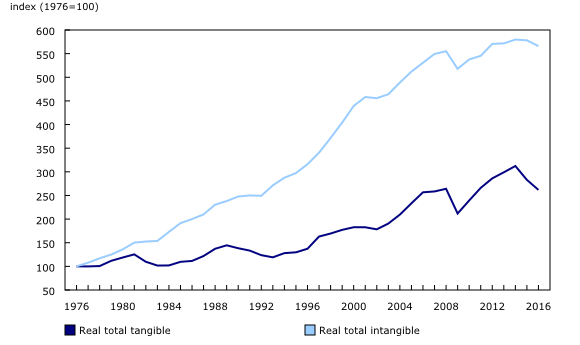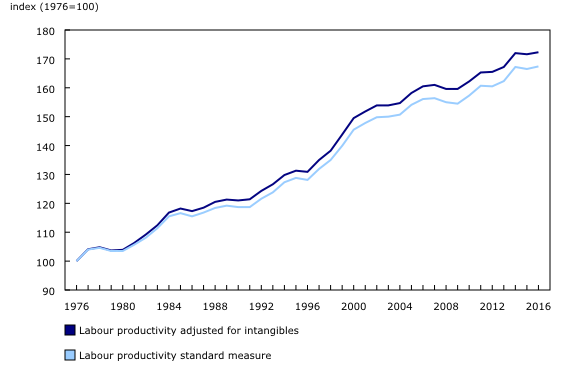Study: Business sector intangible capital and sources of labour productivity growth in Canada
Archived Content
Information identified as archived is provided for reference, research or recordkeeping purposes. It is not subject to the Government of Canada Web Standards and has not been altered or updated since it was archived. Please "contact us" to request a format other than those available.
Released: 2020-02-12
Labour productivity growth slowed in Canada after 2000, despite the seemingly accelerating pace of technological change. A possible explanation for the apparent disconnect is the comprehensiveness of the current definition of intangible capital. After taking into account assets that are not normally defined as intangible capital according to conventional national accounting standards, the contribution of intangible capital to average annual labour productivity growth declined from 0.37 percentage points in the 1976-to-2000 period to 0.23 percentage points in the 2000-to-2016 period.
The study "Business Sector Intangible Capital and Sources of Labour Productivity Growth in Canada" released today presents updated evidence on the role of intangible capital. It also presents for the first time statistics on the expanded set of intangible assets at the provincial level.
To measure intangibles, the paper considers three broad asset classes which align with those being examined in international research: computerized information; innovative property; and economic competencies. The estimates produced for these asset categories align with those produced for the United States and the United Kingdom. Databases are not yet included in the expanded set of intangible assets, as these assets have not yet been integrated into the set of internationally comparable intangibles estimates. Of the assets considered, only computerized information and part of innovative property are currently included in official measures of gross fixed capital formation (GFCF), gross domestic product (GDP) and labour productivity.
The study finds that GFCF in intangible assets grew faster than GFCF in tangible assets from 1976 to 2016. However, the growth in GFCF in intangibles has slowed decade by decade, and in the most recent decade growth in GFCF in intangibles lagged behind growth in GFCF in tangibles.
As GFCF is a component of GDP, the slowing growth in GFCF in intangibles contributes to slowing growth in labour productivity. Average annual labour productivity growth in the business sector slowed from 1.69% in the 1976-to-2000 period to 0.89% in the 2000-to-2016 period. The slowing contribution of intangible capital accounts for roughly 16% of the 0.8 percentage point decline in labour productivity growth between those periods. Although the current study finds that measurement issues associated with the partial coverage of intangibles in the existing GDP estimates are not a factor behind the slower productivity growth after 2000, the findings may change once the value of databases is taken into account.
When assets are disaggregated by industry or by province, the results show the importance of particular intangible assets for particular industries (mineral exploration for mining, oil and gas; research and development for manufacturing, as well as for professional, scientific and technical services), and the importance of particular intangible assets for particular provinces. Often, across provinces, the importance of an intangible asset is related to the main export industries of that province. And, while including intangibles affects the level of GFCF and GDP, in all cases the inclusion of intangibles does not lead to noteworthy changes in labour productivity growth.
Products
The study "Business Sector Intangible Capital and Sources of Labour Productivity Growth in Canada," part of the Analytical Studies Branch Research Paper Series (11F0019M), is now available.
Contact information
Data tables are available upon request.
For more information contact us (toll-free 1-800-263-1136; 514-283-8300; STATCAN.infostats-infostats.STATCAN@canada.ca).
To enquire about the concepts, methods or data quality of this release, contact Ryan Macdonald (613-951-5687; ryan.macdonald@canada.ca), Economic Analysis Division.
- Date modified:



